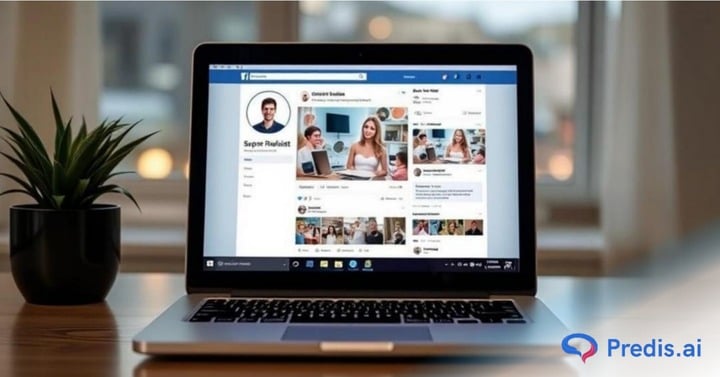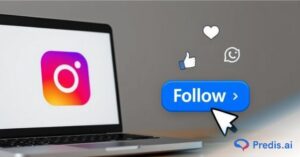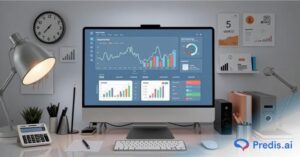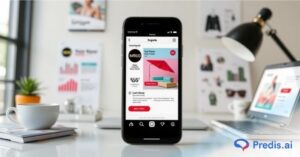Facebook remains one of the most powerful platforms for reaching audiences, whether you’re a small business owner in Leeds, a personal brand in London, or a startup in Manchester. But with users endlessly scrolling, your success comes down to one thing: can your Facebook Ad Headlines stop the scroll?
Here’s the challenge: the average attention span on social media is just 1.7 seconds on mobile, barely enough time for a glance, let alone a second thought. According to McKinsey & Co, 63% of users say they prefer ads that are relevant and feel native to the content they’re already consuming. That’s where your headline makes all the difference.
This blog will teach you how to write Facebook Ad Headlines that get clicked. We’ll break down the psychology behind scroll-stopping copy, share headline formulas used by top-performing brands, and show you how AI tools like Predis.ai can help you generate high-converting headlines faster than ever. Ready to write less fluff and get more clicks? Let’s dive in.
The Psychology Behind High-Converting Facebook Ad Headlines
If you want your Facebook creatives to get clicks in the market, you need more than just clever words—you need psychology. The best headlines tap into how people feel, think, and fear missing out. Let’s break down the key psychological triggers that get results, especially for the audience.
🔍 Curiosity
Curiosity creates an information gap that your brain needs to fill. A good headline teases the benefit without giving it all away.

- Good Example: “This One Trick Doubled Our Leads in a Week (And It’s Not What You Think)”
- Bad Example: “Our Best Marketing Tips” – too vague, no hook.
Subtlety works wonders—don’t shout the answer, invite intrigue.
😱 FOMO (Fear of Missing Out)
FOMO headlines make people feel they’ll lose something by not clicking—whether it’s a deal, knowledge, or social relevance. The right advertising appeal will play the part for you!

- Good Example: “Why 1,000+ Londoners Are Switching to This Skincare Brand Right Now”
- Bad Example: “Check Out Our New Product” – lacks urgency or relevance.
This works especially well in a culture where trends and community choices matter—think festivals, tech, or limited-time offers.
❤️ Emotion
Emotionally charged headlines—whether joyful, outraged, or empathetic—prompt action. Consumers respond well to sincerity and relatability over hype.

- Good Example: “Tired All the Time? This One Habit Changed Everything for Me”
- Bad Example: “Improve Your Daily Routine” – emotionally flat.
Younger audiences, especially Millennials and Gen Z, value realness and emotional advertising over polished perfection.
⏳ Urgency
Urgency pushes action by triggering the fear of delay or missing out on a time-limited opportunity.

- Good Example: “48 Hours Left: Get 30% Off All Vegan Meals in London”
- Bad Example: “Discount Available” – lacks immediacy or specificity.
In a fast-paced online culture, urgent headlines give people a reason to act now.
🇬🇧 Cultural Relevance: Tone Matters
Tone is everything. Writing a good ad copy needs a lot of R&D and the right knowledge. British audiences often favour clever, understated wit over loud, aggressive, salesy language. Headlines like:

- “Not Your Average Brew”
- “Turns Out, Mum Was Right About This One…”
…tend to resonate more than:
- “Buy Now Before It’s Gone!” or “Only Smart People Click This.”
The key? Stay sharp, stay subtle, and know your niche.
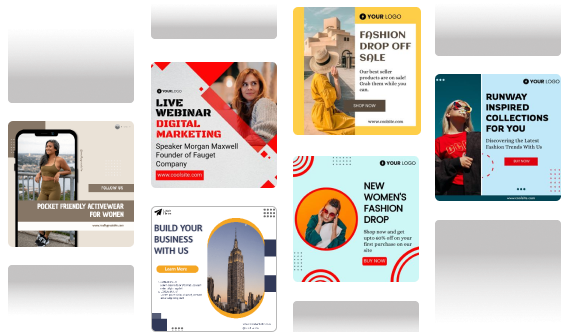
7 Proven Formulas for Writing Facebook Ad Headlines
Want to write Facebook Ad Headlines that get clicks? Then it’s time to stop guessing and start using proven headline formulas that consistently deliver results, especially for today’s digital-savvy generation. Below are 7 high-converting formats that blend psychology, structure, FaceBook size, and relevance to grab attention fast.
1. The List Headline
People love lists—they promise quick wins in a scannable format. This headline type is perfect for content that’s educational or tip-based.
- Example: “7 Ways to Boost Your Home WiFi Speed Without Spending a Penny”

Why it works: It sets a clear expectation and appeals to a logical brain. Lists feel digestible, especially for users casually scrolling during a lunch break or commute.
2. The Question Headline
Asking a question engages curiosity and makes the reader mentally answer it. If the answer is “yes” or “I’m not sure,” you’ve got a click.
- Example: “Struggling with Back Pain in Your 30s?”

Why it works: It identifies a pain point and positions your product or service as the solution—no hard sell needed.
3. The Benefit-Driven Headline
Focus on the outcome, not the features. Let your audience know exactly what they’ll gain by clicking through.
- Example: “Get Glowing Skin in Just 5 Minutes a Day—No Filter Needed”

Why it works: This type of Facebook Ad Headline speaks to transformation and results, which is what users care about.
4. The Shock Factor or Surprising Stat
This style grabs attention by challenging expectations or introducing something unexpected.
- Example: “65% of UK Adults Are Doing This Wrong Every Morning—Are You?”
Why it works: It adds an element of surprise, which disrupts the scroll and invites the reader to learn more.
5. The How-To Headline
“How to” headlines promise clear guidance, which makes them ideal for solution-based content.
- Example: “How to Save £200 a Month Without Changing Your Lifestyle”
Why it works: It offers practical value with a low barrier to entry, great for consumers who love a good life hack.
6. The Time-Sensitive or Seasonal Headline
Adding a time frame creates urgency. Seasonal headlines are especially effective in markets tied to events like Black Friday, Bank Holidays, or even weather shifts.
- Example: “This Bank Holiday Deal Ends Monday—Don’t Miss Out!”
Why it works: Urgency + limited-time window = action. FOMO does the heavy lifting here.
7. The Social Proof Headline
Use numbers or community validation to show that others trust, use, or love what you’re offering.
- Example: “Why 10K Londoners Swear By This Sleep App”
Why it works: Social proof builds credibility fast, especially when paired with relatable demographics.
Facebook Ad Headlines Dos and Don’ts
Writing Facebook Ad Headlines isn’t just about being clever, it’s about being strategic. To win clicks in the UK market, you need to strike a balance between attention-grabbing and authentic. Here’s a cheat sheet of dos and don’ts to help you write headlines that connect with your audience and perform.
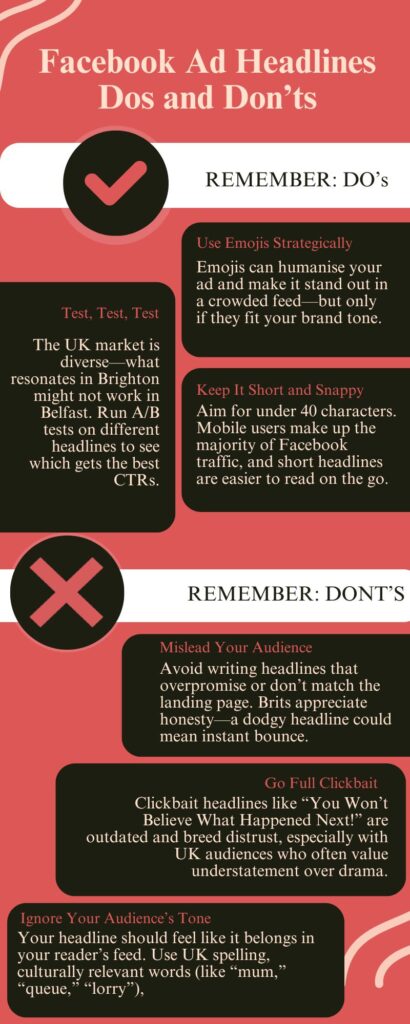
Click-Worthy Facebook Ad Headlines with Predis.ai
Predis.ai is an AI-powered content creation tool specifically designed for marketers and brands looking to scale their social media game.

Here’s how it can supercharge your Facebook Ad Headlines:
🔍 Instant Headline Variations
Instead of struggling with writer’s block, Predis.ai generates multiple headline options in seconds based on your product or campaign theme. You can tweak the tone—witty, professional, urgent—depending on what resonates with your audience.
📊 A/B Testing Made Easy
Predis.ai allows you to test different versions of your headlines and see which one performs best using predictive engagement scores. This takes the guesswork out of crafting the perfect headline.
🇬🇧 Customisable Tone & Market
Whether your brand voice is cheeky, polished, or straight-talking, Predis.ai helps localise your content. You can generate ad headlines with British English spellings, regional slang, and cultural references built in.
🧠 AI Insights Based on Social Trends
Using real-time trend analysis, the tool suggests headline formats and language styles that are performing well right now on platforms like Facebook and Instagram in your niche.
⚡ Faster Campaign Turnaround
Save hours of brainstorming and testing. Predis.ai helps you ideate, write, test, and publish—fast. Perfect for solo marketers, freelancers, or in-house teams managing multiple brands.
Stand Out on Facebook with AI Content 🌟


